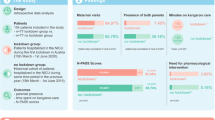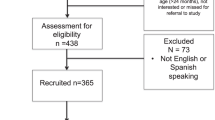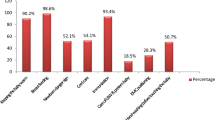Abstract
Objective
Characterize family NICU visitation and examine associations with maternal health and social factors and infant health outcomes.
Study design
Retrospective cohort study of 167 infants born ≤32 weeks at two urban NICUs 01/2019-03/2020. Average nurse-documented family member visitation and associations of visitation with maternal and infant factors and outcomes were compared.
Results
Mothers visited 4.4 days/week, fathers 2.6 days/week, and grandparents 0.4 days/week. Older maternal age, nulliparity, and non-English primary language were associated with more frequent family visitation. Mothers with depression or anxiety history visited less. Maternal depression and public insurance were associated with fewer father visits. Low parental visitation was associated with lower odds of feeding any maternal milk at discharge and low maternal visitation with 11.5% fewer completed infant subspecialty appointments in the year following discharge (95% CI −20.0%, −3.0%).
Conclusion
Families with social disadvantage visited less often. Parental visitation was associated with infant feeding and follow-up.
This is a preview of subscription content, access via your institution
Access options
Subscribe to this journal
Receive 12 print issues and online access
$259.00 per year
only $21.58 per issue
Buy this article
- Purchase on Springer Link
- Instant access to full article PDF
Prices may be subject to local taxes which are calculated during checkout

Similar content being viewed by others
Data availability
The datasets generated during and/or analyzed during the study are available from the corresponding author upon reasonable request.
References
Osterman MJ, Hamilton BE, Martin JA, Driscoll AK, Valenzuela CP Births: Final data for 2020. National Vital Statistics Reports. Hyattsville, MD: National Center for Health Statistics; 2022.
Gooding JS, Cooper LG, Blaine AI, Franck LS, Howse JL, Berns SD. Family support and family-centered care in the neonatal intensive care unit: origins, advances, impact. Semin Perinatol. 2011;35:20–8.
O'Brien K, Robson K, Bracht M, Cruz M, Lui K, Alvaro R, et al. Effectiveness of Family Integrated Care in neonatal intensive care units on infant and parent outcomes: a multicentre, multinational, cluster-randomised controlled trial. Lancet Child Adolesc Health. 2018;2:245–54.
Franck LS, Spencer C. Parent visiting and participation in infant caregiving activities in a neonatal unit. Birth. 2003;30:31–5.
Gonya J, Nelin LD. Factors associated with maternal visitation and participation in skin-to-skin care in an all referral level IIIc NICU. Acta Paediatr. 2013;102:e53–6.
Heinemann A-B, Hellstrom-Westas L, Nyqvist KH. Factors affecting parents’ presence with their extremely preterm infants in a neonatal intensive care room. Acta Paediatr. 2013;102:695–702.
Sigurdson K, Profit J, Dhurjati R, Morton C, Scala M, Vernon L, et al. Former NICU families describe gaps in family-centered care. Qualitative Health Research. 2020;30:1861–75.
Pineda R, Bender J, Hall B, Shabosky L, Annecca A, Smith J. Parent participation in the neonatal intensive care unit: Predictors and relationships to neurobehavior and developmental outcomes. Early Human Dev. 2018;117:32–8.
Smith VC, Hwang SS, Dukhovny D, Young S, Pursley DM. Neonatal intensive care unit discharge preparation, family readiness and infant outcomes: connecting the dots. J Perinatol. 2013;33:415–21.
Feldman R, Rosenthal Z, Eidelman AI. Maternal-preterm skin-to-skin contact enhances child physiologic organization and cognitive control across the first 10 years of life. Biol Psychiatry. 2014;75:56–64.
Brignoni-Perez E, Scala M, Feldman HM, Marchman VA, Travis KE. Disparities in Kangaroo care for premature infants in the neonatal intensive care unit. J Dev Behav Pediatr. 2022;43:e304–11.
Bourque SL, Weikel BW, Palau MA, Greenfield JC, Hall A, Klawetter S, et al. The association of social factors and time spent in the NICU for mothers of very preterm infants. Hosp Pediatr. 2021;11:988–96.
Harmon SL, Conaway M, Sinkin RA, Blackman JA. Factors associated with neonatal intensive care follow-up appointment compliance. Clinical Pediatrics. 2013;52:389–96.
Frankfurt S, Frazier P, Syed M, Jung KR. Using group-based trajectory and growth mixture modeling to identify classes of change trajectories. Counsel Psychol. 2016;44:622–60.
Wardenaar K. Latent Class Growth Analysis and Growth Mixture Modeling using R: A tutorial for two R-packages and a comparison with Mplus. 2020.
Lewis TP, Andrews KG, Shenberger E, Betancourt TS, Fink G, Pereira S, et al. Caregiving can be costly: a qualitative study of barriers and facilitators to conducting kangaroo mother care in a US tertiary hospital neonatal intensive care unit. BMC Pregnancy Childbirth. 2019;19:1–12.
Cordova-Ramos E, Brochier A, Tripodis Y, Garg A, Parker M. Beyond income: material hardship and the health and healthcare of premature children. J Perinatol. 2023;43:357–63.
David RJ, Collins JW. Layers of inequality: power, policy, and health. Am J Public Health. 2014;104:S8–10.
Gershoff ET, Aber JL, Raver CC, Lennon MC. Income is not enough: incorporating material hardship into models of income associations with parenting and child development. Child Dev. 2007;78:70–95.
Lakshmanan A, Agni M, Lieu T, Fleegler E, Kipke M, Friedlich PS, et al. The impact of preterm birth <37 weeks on parents and families: a cross-sectional study in the 2 years after discharge from the neonatal intensive care unit. Health Quality Life Outcomes. 2017;15:1–13.
Lewis M, Bendersky M, Koons A, Hegyi T, Hiatt IM, Ostfeld B, et al. Visitation to a neonatal intensive care unit. Pediatrics. 1991;88:795–800.
American Academy of Pediatrics. Poverty and child health in the United States. Pediatrics. 2016;137:e20160339.
Garg A, Cull W, Olson L, Boyd AF, Federico SG, Dreyer B, et al. Screening and referral for low-income familes’ social determinants of health by US pediatricians. Acad Pediatr. 2019;19:875–83.
Parker MG, Garg A, Brochier A, Rhein LM, Forbes ES, Klawetter S, et al. Approaches to addressing social determinants of health in the NICU: a mixed methods study. J Perinatol. 2021;41:1983–91.
Parker MG, Garg A, McConnell MA. Addressing childhood poverty in pediatric clinical settings: the neonatal intensive care unit is a missed opportunity. JAMA Pediatrics. 2020;174:1135–6.
Cordova-Ramos EG, Kerr S, Heeren T, Drainoni M-L, Garg A, Parker MG. National prevalence of social determinants of health screening among US neonatal care units. Hospital Pediatr. 2022;1:1040–7.
Greene MM, Rossman B, Patra K, Kratovil A, Khan S, Meier PP. Maternal psychological distress and visitation to the neonatal intensive care unit. Acta Paediatr. 2015;104:e306–13.
Vigod S, Villegas L, Dennis C-L, Ross L. Prevalence and risk factors for postpartum depression among women with preterm and low-birth-weight infants: a systematic review. BJOG. 2010;117:540–50.
Rogers C, Kidokoro H, Wallendorf M, Inder T. Identifying mothers of very preterm infants at-risk for postpartum depression and anxiety before discharge. J Perinatol. 2013;33:171–6.
Greene MM, Rossman B, Patra K, Kratovil AL, Janes JE, Meier PP. Depression, anxiety, and perinatal-specific posttraumatic distress in mothers of very low birth weight infants in the neonatal intensive care unit. J Dev Behav Pediatr. 2015;36:362–70.
Behrman RE, Butler AS Preterm birth: causes, consequences, and prevention: National Academies Press; 2007. Available from: https://nap.nationalacademies.org/read/11622.
Beck AF, Edwards EM, Horbar JD, Howell EA, McCormick MC, Pursley DM. The color of health: how racism, segregation, and inequality affect the health and well-being of preterm infants and their families. Pediatr Res. 2020;87:227–34.
Bernardo J, Rent S, Arias-Shah A, Hoge MK, Shaw RJ. Parental stress and mental health symptoms in the NICU: recognition and interventions. NeoReviews. 2021;22:e496–505.
Reynolds L, Duncan M, Smith G, Mathur A, Neil J, Inder T, et al. Parental presence and holding in the neonatal intensive care unit and associations with early neurobehavior. J Perinatol. 2013;33:636–41.
Westrup B. Family-centered developmentally supportive care. NeoReviews. 2014;15:e325–35.
Patel AL, Meier PP, Engstrom JL. The evidence for use of human milk in very low-birthweight preterm infants. NeoReviews. 2007;8:e459–66.
Meier PP. More evidence: Mothers’ own milk is personalized medicine for very low birthweight infants. Cell Rep Med. 2022;3:100710.
Parker MG, Patel AL. Using quality improvement to increase human milk use for preterm infants. Semin Perinatol. 2017;41:175–86.
Andrews KG, Martin MW, Shenberger E, Pereira S, Fink G, McConnell M. Financial support to Medicaid-eligible mothers increase caregiving for preterm infants. Maternal Child Health J. 2020;24:587–600.
Pang EM, Sey R, Beritto TD, Lee HC, Powell CM. Advancing health equity by translating lessons learned from NICU family visitations during the COVID-19 Pandemic. NeoReviews. 2021;22:e1–6.
Davis B, Baggett KM, Patterson AL, Feil EG, Landry SH, Leve C. Power and efficacy of maternal voice in neonatal intensive care units: implicit bias and family-centered care. Maternal Child Health J. 2022;26:905–12.
Acknowledgements
We would like to thank the Yale Department of Pediatrics, Division of Neonatology, and Fellow Academic Funding Award for educational funding support of Leslie Harris for this project. We would also like to acknowledge the Yale Center for Clinical Investigation for the data acquisition for this project; this was made possible by CTSA Grant Number UL1 TR001863 or KL2 TR001862 or TL1 TR001864 (as appropriate) from the National Center for Advancing Translational Science (NCATS), a component of the National Institutes of Health (NIH). The contents of this publication are solely the responsibility of the authors and do not necessarily represent the official view of Yale University or the NIH.
Author information
Authors and Affiliations
Contributions
LMH contributed to the study conception and design, coordinated data acquisition, cleaned and analyzed the data, drafted the initial manuscript, and critically reviewed and revised the manuscript. VS contributed to the study design, supervised data cleaning and statistical analyses, performed statistical analyses, and critically reviewed and revised the manuscript. JMB advised the study design and critically reviewed and revised the manuscript. DL and BD contributed to data collection and critically reviewed and revised the manuscript. MP contributed to the study conception and design and critically reviewed and revised the manuscript. SNT contributed to the study conception and design, supervised data acquisition, and critically reviewed and revised the manuscript. All authors approved the final manuscript as submitted and agree to be accountable for all aspects of the work.
Corresponding author
Ethics declarations
Competing interests
SNT is the site principal investigator for studies funded by Ferring Pharmaceuticals, Pfizer, and Prolacta Bioscience. SNT has served as a content expert for the Vermont Oxford Network.
Ethics
This study was approved by the Yale Human Research Protection Program Institutional Review Boards (protocol ID 2000030868) and performed in accordance with the Declaration of Helsinki.
Additional information
Publisher’s note Springer Nature remains neutral with regard to jurisdictional claims in published maps and institutional affiliations.
Supplementary information
Rights and permissions
Springer Nature or its licensor (e.g. a society or other partner) holds exclusive rights to this article under a publishing agreement with the author(s) or other rightsholder(s); author self-archiving of the accepted manuscript version of this article is solely governed by the terms of such publishing agreement and applicable law.
About this article
Cite this article
Harris, L.M., Shabanova, V., Martinez-Brockman, J.L. et al. Parent and grandparent neonatal intensive care unit visitation for preterm infants. J Perinatol 44, 419–427 (2024). https://doi.org/10.1038/s41372-023-01745-x
Received:
Revised:
Accepted:
Published:
Issue Date:
DOI: https://doi.org/10.1038/s41372-023-01745-x



